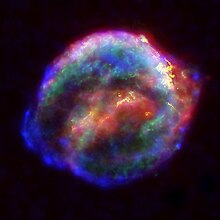Supernova nucleosynthesis
Supernova nucleosynthesis is the production of new chemical elements inside supernovae. It occurs primarily due to explosive nucleosynthesis during explosive oxygen burning and silicon burning.[1] Those fusion reactions create the elements silicon, sulfur, chlorine, argon, sodium, potassium, calcium, scandium, titanium and iron peak elements: vanadium, chromium, manganese, iron, cobalt, and nickel. As a result of their ejection from supernovae, their abundances increase within the interstellar medium. Elements heavier than nickel are created primarily by a rapid capture of neutrons in a process called the R-process. However, there are other processes thought to be responsible for some of the nucleosynthesis of heavy elements, notably a proton capture process known as the Rp-process and a photodisintegration process known as the gamma (or p) process. The latter synthesizes the lightest, most neutron-poor, isotopes of the heavy elements.
Supernova
A supernova is a massive explosion of a star that occurs under two principal scenarios. The first is that a white dwarf star undergoes a nuclear based explosion after it reaches its Chandrasekhar limit after absorbing mass from a neighboring star (usually a red giant). The second, and more common, cause is when a massive star, usually a red giant, reaches Nickel-56 in its nuclear fusion (or burning) processes. This isotope undergoes radioactive decay into Iron-56, which has one of the highest binding energies of all of the isotopes, and is the last element that produces a net release of energy by nuclear fusion, exothermically. All nuclear fusion reactions that produce heavier elements cause the star to lose energy or are said to be endothermic reactions. The pressure that supports the star's outer layers drops sharply. As the outer envelope is no longer sufficiently supported by the radiation pressure, the star's gravity pulls its outer layers rapidly inward. The star collapses very quickly, and strikes the incompressible core causing a shockwave that progresses outward through the unfused material of the outer shell. The pressures and densities in the shockwave are sufficient to induce fusion in that material and the star explodes.
Elements fused

In nuclear fusion processes during stellar nucleosynthesis, the maximum weight for an element fused is that of iron, reaching an isotope with an atomic mass of 56. Prior to a supernova, fusion of elements between silicon and iron occurs only in the largest of stars, in the Silicon burning process. A slow neutron capture process, known as the S-process which also occurs during normal stellar nucleosynthesis can create elements up to bismuth with an atomic mass of approximately 209. However, the s-process occurs primarily in low-mass stars that evolve more slowly. Once the core fails to produce enough energy to support the outer envelope of gasses the star explodes as a supernova producing the bulk of elements beyond iron. Production of elements from iron to uranium occurs within seconds in a supernova explosion. Due to the large amounts of energy released, much higher temperatures and densities are reached than at normal stellar temperatures. These conditions allow for an environment where transuranium elements might be formed.
The r-process
During supernova nucleosynthesis, the r process (r for rapid) creates very neutron-rich heavy isotopes, which decay after the event to the first stable isotope, thereby creating the neutron-rich stable isotopes of all heavy elements. This neutron capture process occurs in high neutron density with high temperature conditions. In the r process, any heavy nuclei are bombarded with a large neutron flux to form highly unstable neutron rich nuclei which very rapidly undergo beta decay to form more stable nuclei with higher atomic number and the same atomic weight. The neutron flux is astonishingly high, about 1022 neutrons per square centimeter per second. First calculation of a dynamic r process, showing the evolution of calculated results with time,[2] also suggested that the r process abundances are a superposition of differing neutron fluences. Small fluence produces the first r process abundance peak near atomic weight A=130 but no actinides, whereas large fluence produces the actinides uranium and thorium but no longer contains the A=130 abundance peak. These processes occur in a fraction of a second to a few seconds, depending on details. Hundreds of subsequent papers published have utilized this time-dependent approach. Interestingly, the only modern nearby supernova, 1987A, has not revealed r process enrichments. Modern thinking is that the r process yield may be ejected from some supernovae but swallowed up in others as part of the residual neutron star or black hole.
See also
|
|
References
- ^ Woosley, S.E., W. D. Arnett and D. D. Clayton (1973). "Explosive burning of oxygen and silicon". The Astrophysical Journal Supplement. 26: 231–312. Bibcode:1973ApJS...26..231W. doi:10.1086/190282.
{{cite journal}}: CS1 maint: multiple names: authors list (link) - ^ P. A. Seeger, W.A. Fowler, D. D. Clayton (1965). "Nucleosynthesis of heavy elements by neutron capture". The Astrophysical Journal Supplement. 11: 121–166. Bibcode:1965ApJS...11..121S. doi:10.1086/190111.
{{cite journal}}: CS1 maint: multiple names: authors list (link)
Other reading
- E. M. Burbidge, G. R. Burbidge, W. A. Fowler, F. Hoyle, Synthesis of the Elements in Stars, Rev. Mod. Phys. 29 (1957) 547 (article at the Physical Review Online Archive).
- D. D. Clayton, "Handbook of Isotopes in the Cosmos", Cambridge University Press, 2003, ISBN 0-521-82381-1.
External links
- Atom Smashers Shed Light on Supernovae, Big Bang Sky & Telescope Online, April 22, 2005
- G. Gonzalez, D. Brownlee, P. Ward (2001). "The Galactic Habitable Zone: Galactic Chemical Evolution" (PDF). Icarus. 152: 185–200. arXiv:astro-ph/0103165. Bibcode:2001Icar..152..185G. doi:10.1006/icar.2001.6617.
{{cite journal}}: CS1 maint: multiple names: authors list (link)


